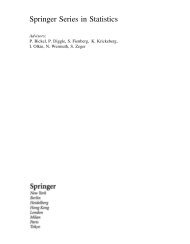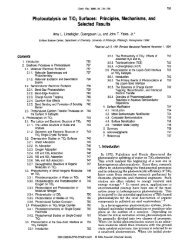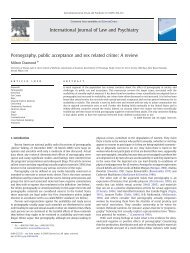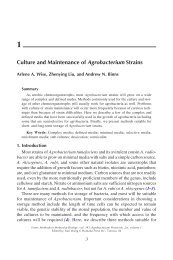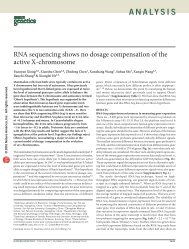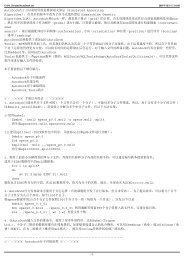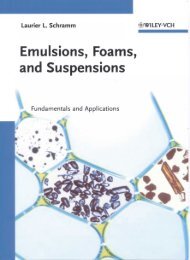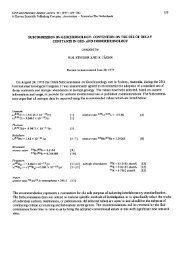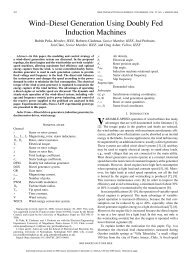Create successful ePaper yourself
Turn your PDF publications into a flip-book with our unique Google optimized e-Paper software.
Cell<br />
364<br />
Enari, M., Hug, H., and Nagata, S. (1995b). Involvement of an ICE- Korsmeyer, S.J. (1995). Bax-deficient mice with lymphoid hyperpla-<br />
like protease in Fas-mediated apoptosis. Nature 375, 78–81.<br />
sia and male germ cell death. Science 270, 96–99.<br />
Enari, M., Talanian, R.V., Wong, W.W., and Nagata, S. (1996). Se- Krippner, A., Matsuno-Yagi, A., Gottlieb, R., and Babior, B. (1996).<br />
quential activation of ICE-like and CPP32-like proteases during Fas- Loss of function of cytochrome c in Jurkat cells undergoing Fas-<br />
mediated apoptosis. Nature 380, 723–726.<br />
mediated apoptosis. J. Biol. Chem. 271, 21629–21636.<br />
Fisher, G.H., Rosenberg, F.J., Straus, S.E., Dale, J.K., Middelton, Kuida, K., Zheng, T.S., Na, S.-Q., Kuan, C.-Y., Yang, D., Karasuyama,<br />
L.A., Lin, A.Y., Strober, W., Lenardo, M.J., and Puck, J.M. (1995). H., Rakic, P., and Flavell, R.A. (1996). Decreased apoptosis in the<br />
Dominant interfering Fas gene mutations impair apoptosis in a hu- brain and premature lethality in CPP32-deficient mice. Nature 384,<br />
man autoimmune lymphoproliferative syndrome. Cell 81, 935–946. 368–372.<br />
Gajewski, T.F., and Thompson, C.B. (1996). <strong>Apoptosis</strong> meets signal Lau, H.T., Yu, M., Fontana, A., and Stoeckert Jr., C.J. (1996). Preventransduction:<br />
elimination of BAD influence. Cell 87, 589–592.<br />
tion of islet allograft rejection with engineered myoblasts expressing<br />
Gamen, S., Marzo, I., Anel, A., Piñeiro, A., and Naval, J. (1996).<br />
FasL in mice. Science 273, 109–112.<br />
CPP32 inhibition prevents Fas-induced ceramide generation and Lenczowski, J.M., Dominguez, L., Eder, A., King, L.B., Zacharchuk,<br />
apoptosis in human cells. FEBS Lett. 390, 233–237.<br />
C.M., and Ashwell, J.D. (1997). Lack of a role for Jun kinase and<br />
Gearing, A.J.H., Beckett, P., Christodoulou, M., Churchill, M., Clements,<br />
J., Davidson, A.H., Drummond, A.H., Galloway, W.A., Gilbert,<br />
R., Gordon, J.L., et al. (1994). Processing of tumor necrosis fac-<br />
tor-� precursor <strong>by</strong> metalloproteinases. Nature 370, 555–557.<br />
Grell, M., Douni, E., Wajant, H., Löhden, M., Maxeiner, B., Georgopoulos,<br />
S., Lesslauer, W., Kollias, G., Pfizenmaier, K., and Scheurich,<br />
P. (1995). The transmembrane form of the tumor necrosis factor is<br />
the prime activating ligand of the 80 kDa tumor necrosis factor<br />
receptor. Cell 83, 793–802.<br />
AP-1 in Fas-induced apoptosis. Mol. Cell. Biol. 17, 170–181.<br />
Li, P., Allen, H., Banerjee, S., Franklin, S., Herzog, L., Johnston, C.,<br />
McDowell, J., Paskind, M., Rodman, L., Salfeld, J., et al. (1995). Mice<br />
deficient in IL-1�-Converting enzyme are defective in production of<br />
mature IL-1� and resistant to endotoxic shock. Cell 80, 401–411.<br />
Liu, Z.-G., Hsu, H., Goeddel, D., and Karin, M. (1996). Dissection of<br />
TNF receptor 1 effector functions: JNK activation is not linked to<br />
apoptosis while NF-�B activation prevents cell death. Cell 87,<br />
565–576.<br />
Griffith, T.S., Brunner, T., Fletcher, S.M., Green, D.R., and Ferguson,<br />
T.A. (1995). Fas ligand–induced apoptosis as a mechanism of immune<br />
privilege. Science 270, 1189–1192.<br />
Los, M., Van de Craen, M., Penning, L.C., Schenk, H., Westendorp,<br />
M., Baeuerle, P.A., Dröge, W., Krammer, P.H., Fiers, W., and Schulze-<br />
Osthoff, K. (1995). Requirement of an ICE/CED-3 protease for Fas/<br />
APO-1-mediated apoptosis. Nature 375, 81–83.<br />
Hahne, M., Rimoldi, D., Schröter, M., Romero, P., Schreier, M.,<br />
French, L.E., Schneider, P., Bornand, T., Fontana, A., Lienard, D.,<br />
et al. (1996). Melanoma cell expression of Fas(Apo-1/CD95) ligand:<br />
Implications for tumor immune escape. Science 274, 1363–1366.<br />
Hengartner, M.O., and Horvitz, H.R. (1994). C. elegans cell survival<br />
gene ced-9 encodes a functional homolog of the mammalian protooncogene<br />
bcl-2. Cell 76, 665–676.<br />
Montogomery, R.I., Warner, M.S., Lum, B.J., and Spear, P.G. (1996).<br />
Herpes simplex virus-1 entry into cells mediated <strong>by</strong> a novel member<br />
of the TNF/NGF receptor family. Cell 87, 427–436.<br />
Motoyama, N., Wang, F., Roth, K.A., Sawa, H., Nakayama, K., Nakayama,<br />
K., Negishi, I., Senju, S., Zhang, Q., Fujii, S., and Loh, D.Y.<br />
(1995). Massive cell death of immature hematopoietic cells and neu-<br />
rons in Bcl-x-deficient mice. Science 267, 1506–1510.<br />
Hsu, H., Xiong, J., and Goeddel, D.V. (1995). The TNF receptor<br />
1–associated protein TRADD signals cell death and NF-�B activation.<br />
Cell 81, 495–504.<br />
Muchmore, S.W., Sattlet, M., Liang, H., Meadows, R.P., Harlan, J.E.,<br />
Yoon, H.S., Nettesheim, D., Chang, B.S., Thompson, C.B., Wong,<br />
S.L., Ng, S.L., and Fesik, S.W. (1996). X-ray and NMR structure of<br />
Hsu, H., Huang, J., Shu, H.-B., Baichwal, V., and Goeddel, D. (1996a). human Bcl-xL, an inhibitor of programmed cell death. Nature 381,<br />
TNF-dependent recruitment of the protein kinase RIP to the TNF 335–341.<br />
receptor-1 signaling complex. Immunity 4, 387–396.<br />
Muzio, M., Chinnaiyan, A.M., Kischkel, F.C., O’Rourke, K., Shev-<br />
Hsu, H., Shu, H.-B., Pan, M.-G., and Goeddel, D.V. (1996b). TRADD– chenko, A., Ni, J., Scaffidi, C., Bretz, J.D., Zhang, M., Gentz, R., et<br />
TRAF2 and TRADD–FADD interactions define two distinct TNF re- al. (1996). FLICE, a novel FADD-homologous ICE/CED-3-like proteceptor<br />
1 signal transcription pathways. Cell 84, 299–308. ase, is recruited to the CD95(Fas/APO-1) death-inducing signaling<br />
Huang, B., Eberstadt, M., Olejniczak, E.T., Meadows, R.P., and complex. Cell 85, 817–827.<br />
Fesik, S.W. (1996). NMR structure and mutagenesis of the Fas (Apo- Nagata, S., and Golstein, P. (1995). The Fas death factor. Science<br />
1/CD95) death domain. Nature 384, 638–641.<br />
267, 1449–1456.<br />
Itoh, N., Yonehara, S., Ishii, A., Yonehara, M., Mizushima, S., Same- Nicholson, D.W., Ali, A., Thornberry, N.A., Vaillancourt, J.P., Ding,<br />
shima, M., Hase, A., Seto, Y., and Nagata, S. (1991). The polypeptide C.K., Gallant, M., Gareau, Y., Griffin, P.R., Labelle, M., Lazebnik,<br />
encoded <strong>by</strong> the cDNA for human cell surface antigen Fas can medi- Y.A., et al. (1995). Identification and inhibition of the ICE/CED-3<br />
ate apoptosis. Cell 66, 233–243.<br />
protease necessary for mammalian apoptosis. Nature 376, 37–43.<br />
Itoh, N., and Nagata, S. (1993). A novel protein domain required for Oehm, A., Behrmann, I., Falk, W., Pawlita, M., Maier, G., Klas, C.,<br />
apoptosis: mutational analysis of human Fas antigen. J. Biol. Chem. Li-Weber, M., Richards, S., Dhein, J., Trauth, B.C., et al. (1992).<br />
268, 10932–10937.<br />
Purification and molecular cloning of the APO-1 cell surface antigen,<br />
Itoh, N., Tsujimoto, Y., and Nagata, S. (1993). Effect of bcl-2 on Fas<br />
antigen–mediated cell death. J. Immunol. 151, 621–627.<br />
a member of the tumor necrosis factor/nerve growth factor receptor<br />
superfamily: sequence identity with the Fas antigen. J. Biol. Chem.<br />
267, 10709–10715.<br />
Jacobson, M.D., Weil, M., and Raff, M.C. (1997). Programmed cell<br />
death in animal development. Cell, this issue.<br />
Ogasawara, J., Watanabe-Fukunaga, R., Adachi, M., Matsuzawa,<br />
A., Kasugai, T., Kitamura, Y., Itoh, N., Suda, T., and Nagata, S. (1993).<br />
Jones, E.Y., Stuart, D.I., and Walker, N.P.C. (1989). Structure of Lethal effect of the anti-Fas antibody in mice. Nature 364, 806–809.<br />
tumour necrosis factor. Nature 338, 225–228.<br />
Rieux-Laucat, F., Le Deist, F., Hivroz, C., Roberts, I.A., Debatin,<br />
Kischkel, F.C., Hellbardt, S., Behrmann, I., Germer, M., Pawlita, M., K.M., Fischer, A., and de Villarty, J.P. (1995). Mutations in Fas associ-<br />
Krammer, P.H., and Peter, M.E. (1995). Cytotoxicity-dependent ated with human lymphoproliferative syndrome and autoimmunity.<br />
APO-1 (Fas/CD95)-associated proteins from a death-inducing sig- Science 268, 1347–1349.<br />
naling complex (DISC) with the receptor. EMBO J. 14, 5579–5588.<br />
Rodriguez, I., Matsuura, K., Ody, C., Nagata, S., and Vassalli, P.<br />
Kiston, J., Raven, T., Jiang, Y.-P., Goeddel, D.V., Giles, K.M., Pun, (1996a). Systemic injection of a tripeptide inhibits the intracellular<br />
K.-T., Grinham, C.J., Brown, R., and Farrow, S.N. (1996). A death- activation of CPP32-like proteases in vivo and fully protects mice<br />
domain-containing receptor that mediates apoptosis. Nature 384, against Fas-mediated fulminant liver destruction and death. J. Exp.<br />
372–375. Med., in press.<br />
Knudson, C.M., Tung, K.S., Tourtellotte, W.G., Brown, G.A., and<br />
Rodriguez, I., Matsuura, K., Khatib, K., Reed, J.C., Nagata, S., and




